Frankly, I am not very interested in philosophy. It's too abstract for me. I can't even bear the philosophy blog in the New York Times, (The Stone: "a forum for contemporary philosophers on issues both timely and timeless") which I think is intended optimistically for those who are as challenged as I am by abstractions.
However, by some chance and a library visit, I recently read several novels with philosophy integrated more or less into the narrative. In the most simple-minded view, each of these novels explores a philosophical problem through both the actions and the conversations of the characters. I was very interested in how the authors handled abstract ideas and integrated them into the plots, and in the similarities between these highly different novels.
After Many a Summer Dies the Swan by Aldous Huxley (published 1939) is concerned with the finality of death and by extension what the idea of death does to those who obsess about it. The book includes both satirical and semi-serious themes, so it's a bit hard to discuss. One central character is a Los Angeles real estate millionaire (that's a lot of money in 1939), who despite ownership of a highly profitable Forest-Lawn-type cemetery is terrified by death. Using his vast wealth, he hires a scientist to find him a cure for mortality, and also hires a typical English scholar to go over some papers he's obtained that might record an earlier attempt at immortality. In addition to these men, there's a beautiful 22 year old bimbo (not called that) who tries to make him feel young while enjoying the luxury he offers her. It's a very male book.
The scholar, the scientist, and another convenient scholar in the neighborhood have endless discussions about philosophy of death. Alas, the conversations are not satire. I found it tempting to skip the philosophy and just enjoy the comic parts. Sometimes Huxley takes the scholars more seriously than other times; unfortunately not a single one of the characters is in my opinion at all sympathetic. This is a flaw in the book if you ask me.
Before philosophic discussions bored me to death, I felt that the plot took off, so I read the whole thing without flagging. At the end the scientist and the rich man travel to England where World War II is breaking out, though I couldn't figure out its relevance. Philosophical discussions are abandoned as they find that the centuries-prior experimentation with a cure for aging had made two people immortal; however, it also turned them into a sort of apes. So what they searched wasn't in fact exactly what they wanted -- except the foolish rich man, who is sent-up one more time by saying the ape-like existence didn't look that bad. The ending makes the philosophy seem even more tacked-on than it did during the novel.
Conclusion: this particular novel is not very successful as a philosophic platform.
State of Wonder by Ann Patchett (2011) focuses on scientists searching in the Amazon for a drug that will make women fertile for their entire lives. They are studying a tribe whose tree-bark-eating habits have this effect. The scientists have a lab in the jungle and are experimenting with turning the bark into a marketable drug for the pharmaceutical company that pays their way. The central character visits the lab (with great difficulty) because she is searching for a colleague who has died; the plot centers around how she learns from her experience -- to put it bluntly and oversimplify.
Patchett incorporates a number of philosophic ideas into the novel, but rather than conversations, these ideas come up as the characters' moral dilemmas. The scientists in the jungle constantly have to deal with questions about the value of what they do, and about their responsibility for interactions with the tribe they are living with. Should they introduce Western medical treatments and antibiotics when their hosts are ill or injured? Should they communicate other Western ideas? Share their canned and processed food? Learn the local languages? Each dilemma comes out of a carefully-presented situation, and the characters have strong ideas on what is ethical and moral.
Finally, the characters have to face the most fundamental question: would it even be ethical to enable women to bear children all their lives? The way this dilemma arises is the most adroitly written part of the book. Again, what they are looking for doesn't quite turn out to be what they really want. These are highly sympathetic and beautifully realized characters, and the plot is complex. I wouldn't have skipped a word.
Conclusion: this novel beautifully embodies ideas and what I would call philosophy along with character development and suspenseful events. Especially wonderfully, it contains one extremely well-presented and memorable character, an elderly woman doctor who is leading the jungle experimental station.
He, She, and It by Marge Piercy (1992) is science fiction set in 2059, in a post-nuclear distopian world. The scientists in this world are computer and robotics experts who have created a golem; that is, a machine that can think, feel, and possibly act with free will, and who successfully mimics humans physically, mentally, and emotionally. The main story of the novel is about the creation and development of this creature, his role in the characters' struggle with their enemies, and about the terrible world that has emerged from human errors of the past.
The events of 2059 are interspersed with the story of the original Golem of Prague, told with wonderful imagined details by one of the characters in the book. Plot and characters in both story lines are developed in a way I find compelling, though I don't feel like writing a summary here.
In my view, the increasing parallelism between the two golem stories as they unfold is one of the most enjoyable features of the book. Both stories end up asking the same question, a moral question embodied in both: is it right to make a creature that is aware of itself yet created to serve its creators? The interrelated stories also ask about the dangers of such a creature to its creators. And again, as in the other books, the modern scientists/medieval kabbalists got what they were striving for, but learned that it was not truly what they wanted.
Conclusion: like State of Wonder, plot and characters in this novel beautifully embody the ideas and questions that it explores. I'm impressed by the successful embedding of the older tale in the sci-fi like future story.
The Marriage Plot by Jeffrey Eugenides (2012) isn't so much about any philosophical ideas as about late adolescents who drop the names of modern philosophers. It's beyond pretentious. Maybe there could be a book about name-dropping that doesn't suffer from too much name-dropping, but this isn't it. Eugenides constantly seems to be trying to demonstrate his bona-fides as a knowledgeable reader of deconstruction, not just writing a novel. I've only read around 100 pages and I'm fed up.
Would I like it better if the adolescent characters discussed (or even thought about) the ideas in their college philosophy classes? Doubtful. Am I just unable to cope with a book about young people? Well, I do like Jane Austen a lot. And the Harry Potter books. And even sort of liked The Hunger Games. And many others. In fact, I really liked Eugenides' earlier book, Middlesex, about a very young central character. I'm not guilty of wanting everyone to be old.
I can't believe the number of people I've read of or talked to who have started but not finished this book, and I might have joined them. It's really, alas, a tedious read, and I can't make myself care if the characters want something or not, much less to find out if they get it as in the other books. If I go back to reading the book, I will append something here.
Monday, August 20, 2012
Friday, August 17, 2012
African World Festival, Detroit

Our new African Mask: A "Sickness Mask"from the Congo
This afternoon we walked around the sales booths for the African World Festival, sponsored by the Detroit Museum of African American History. The festival will present a number of events tomorrow, but we just happened to be there today. We went to Detroit to see an exhibit of five Spanish paintings by Velazquez, Picasso, Dali, ElGreco, and Goya at the Detroit Institute of Arts across the street.
The festival was quiet, but very colorful. I'm sure it will become much more crowded as the weekend progresses, and I'm glad we were there at a calm time.



Several of the many booths offered a wide selection of African masks and other traditional wood carvings, both antique and modern. We bought our new mask from Billo Berete of Newark, N.J. -- below, Len in the booth:


There were many other masks in this booth, including two more Sickness Masks, as shown above. As I understand it, sickness masks are characterized by asymmetry, contrasting colors on opposite sides of the face or double faces, and sometimes by anguished looks. The mask at left in the middle was an extremely wonderful piece, made not only of wood but also mud, seeds, and cloth. It's probably more authentic than the one we bought, but it was too vivid for my taste. It made me anxious!
For more information on Sickness Masks, including images, see the second half of my July, 2009, post "Why do I like African Masks?"
Tuesday, August 14, 2012
Mona Lisa Suddenly Appears in Google+
Today's Mona Lisa -- a leaf carved with her image. See this:
YouTube: Did You Know :Leaf Carving China Slide Show
Monday, August 13, 2012
New Mona Lisa Objects
My collection grows rather slowly these days, but here are a few new items. The cards were for my birthday recently, as was also the promotion for a picture framing shop in Vermont. The mona lisa mints are from the Santa Barbara art museum, where I also bought another object but I'm still working on an effective photo of it.
Sunday, August 05, 2012
Mountains
The Tetons impress me more than any other mountains I have seen. The wide meadows and reflecting lakes at the foot of the mountain range provide scenic views of power and beauty.

Grand Teton mountain lit by the first rays of the rising sun. It's the tallest of the peaks, so the sunlight reaches it first.

More early morning sunlight on the mountains.
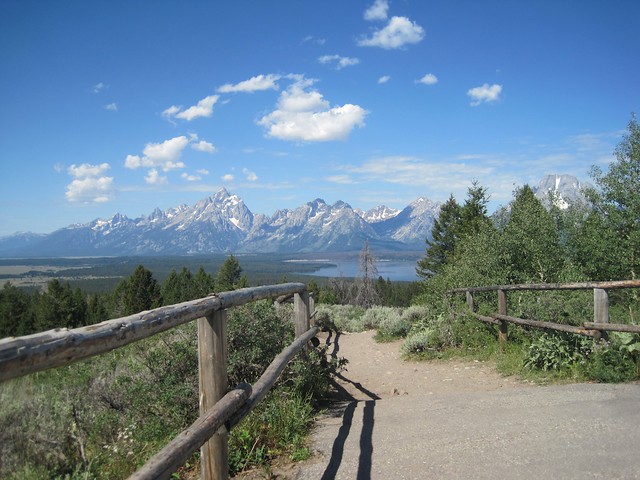
The Tetons and Jackson Lake, seen from Signal Hill. This is high above the plain with panoramic views of the horizon in all directions. The road winds around Signal Hill several times as you ascend. The last part is a bit hair-raising, as it goes across a little spine. I don't know what signals they used when they chose the name, but obviously now, there's a huge cell-phone tower near the top.
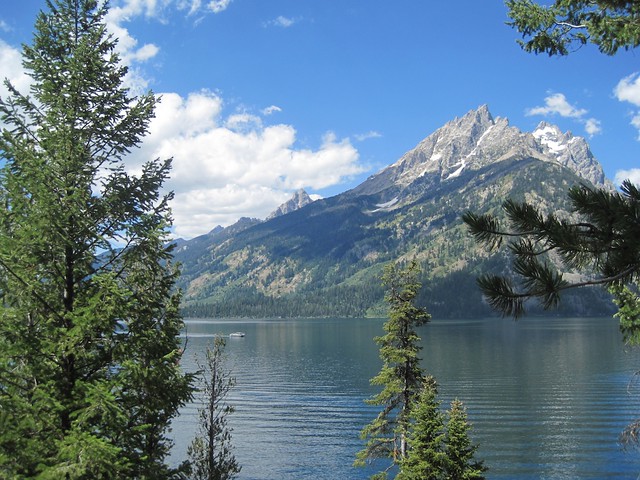
View across Jenny Lake. After stopping at this viewpoint, we drove to the visitor center and took a boat across the lake to a hiking trail.

From the hiking trail, we saw the mountains from a number of perspectives, one more beautiful than the next!

View from a turnout along the road.
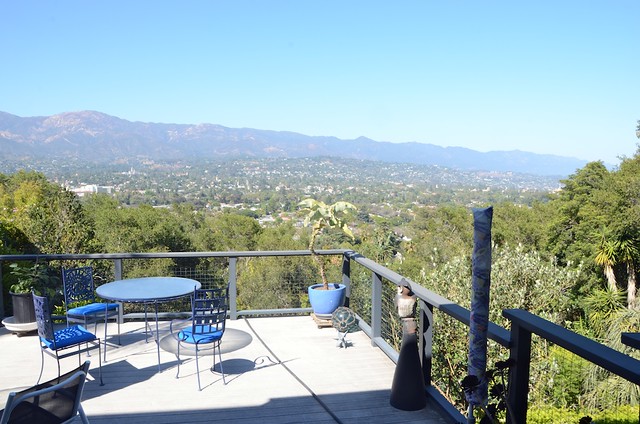
We also enjoyed our view of the California coastal mountains from our Santa Barbara apartment. This shows our deck.
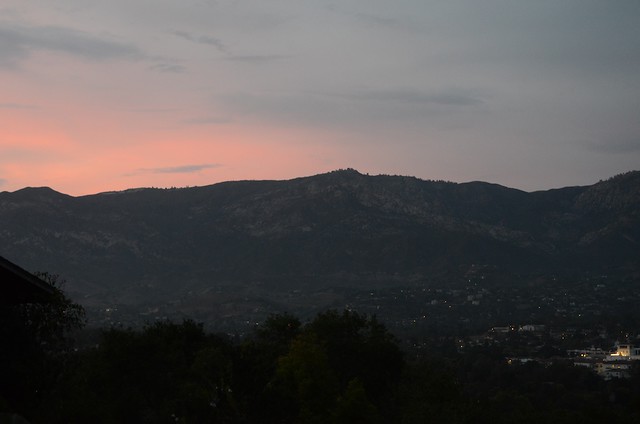
Santa Barbara view at sunset.

Grand Teton mountain lit by the first rays of the rising sun. It's the tallest of the peaks, so the sunlight reaches it first.

More early morning sunlight on the mountains.

The Tetons and Jackson Lake, seen from Signal Hill. This is high above the plain with panoramic views of the horizon in all directions. The road winds around Signal Hill several times as you ascend. The last part is a bit hair-raising, as it goes across a little spine. I don't know what signals they used when they chose the name, but obviously now, there's a huge cell-phone tower near the top.

View across Jenny Lake. After stopping at this viewpoint, we drove to the visitor center and took a boat across the lake to a hiking trail.

From the hiking trail, we saw the mountains from a number of perspectives, one more beautiful than the next!

View from a turnout along the road.

We also enjoyed our view of the California coastal mountains from our Santa Barbara apartment. This shows our deck.

Santa Barbara view at sunset.
Saturday, August 04, 2012
Columnar Basalt at Yellowstone
Yellowstone is full of volcanic features, including this columnar basalt at Sheepeater Cliff (named for Shoshone Indians who raised bighorn sheep and who sometimes used this area). The columns formed during the cataclysmic volcanic activity of around half a million years ago, which created many of the distinctive features of the park. Yellowstone has several such basalt formations.

Marmots live among the columns:
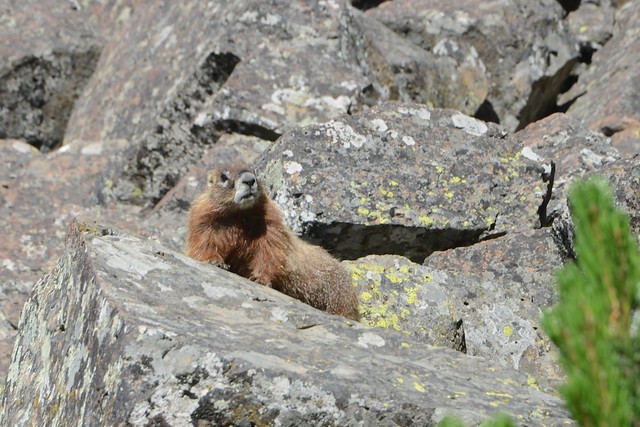
Columnar basalt is extremely fascinating -- we saw perhaps the most spectacular example a couple of years ago at the Giant's Causeway in Ireland, where the tops of the columns form what appears to be a tiled pavement made by giants:
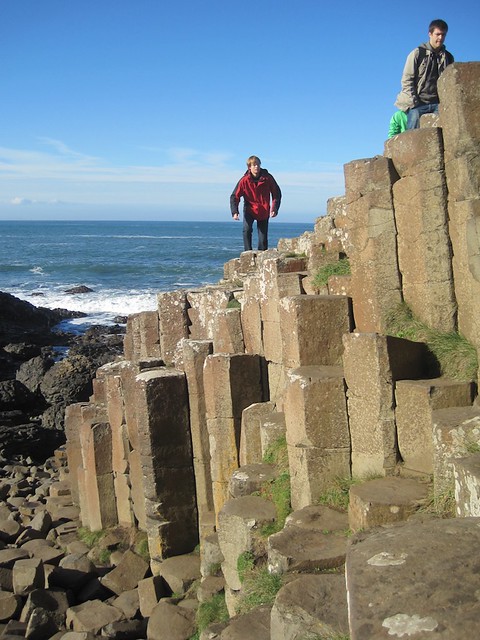

Marmots live among the columns:

Columnar basalt is extremely fascinating -- we saw perhaps the most spectacular example a couple of years ago at the Giant's Causeway in Ireland, where the tops of the columns form what appears to be a tiled pavement made by giants:

Thursday, August 02, 2012
Geysers

The main event at Yellowstone is geyser eruptions. Old Faithful is of course best known, as it's large and has a schedule almost like clockwork. We watched 5 eruptions in the three days we were in the park, the last being at sunset as we returned from a walk around the Old Faithful Geyser Basin. The setting sun was turning the steam clouds a beautiful shade of pink.
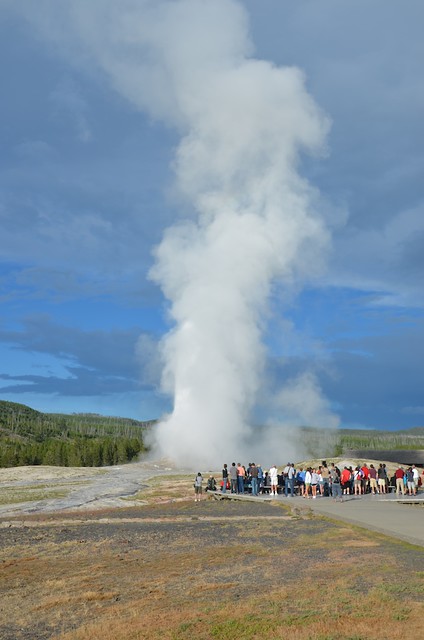
Old Faithful attracts a crowd at almost every eruption; private cars, group vehicles, and tour buses pour into the parking lot shortly before the expected moment. I found it interesting that the famously predictable schedule has slowly changed during the approximately 100 years of the park's existence. Now 90 minutes, in the early days it was closer to an hour between eruptions.
The Old Faithful Geyser Basin is the largest grouping of geysers in the world. Some erupt from little pools; others have formed cones or irregular shapes as a result of the accumulated mineral deposits. The basin also includes a number of springs and pools, a boiling pool with steam bubbles seething at the surface, and beautiful surrounding woods and streams.
Across the river and the fields, the historic Old Faithful Inn, which opened in 1904, has become a feature of the landscape as well. (We stayed there, but weren't really that happy about it, as our room was neither historic nor well-maintained -- it was in a mid-20th-century cheap addition. Peeling paint and rotten plaster? No chairs to sit on? Please! But I digress. Our other night near Old Faithful was at Snow Lodge, which met all our expectations, and lived up to our experiences in other historic buildings in national parks.)

Old Faithful Inn from the Geyser Basin
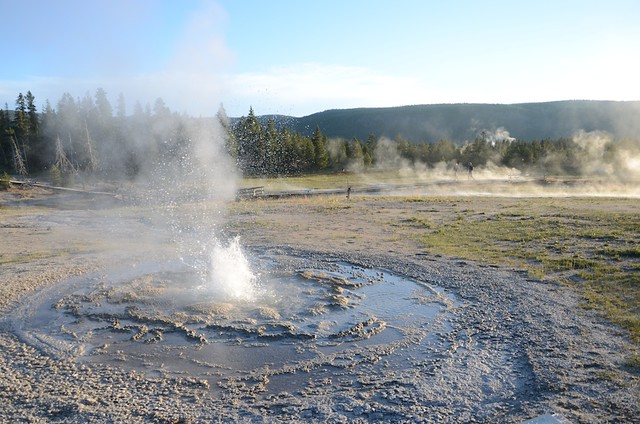

Geysers vary enormously, from tiny ones (as above) up to the erratic Steamboat Geyser with a steam jet as high as 380 feet. Steamboat, around 30 minutes drive from Old Faithful in the Norris Geyser Basin, was active for a few years beginning in around 2000: its last big eruption was in May, 2005. When we walked there, it was emitting a small but still impressive series of steam puffs.

Steamboat Geyser as we saw it.
I found that each thermal basin has its own interesting look and characteristics. Norris, which is larger and has the thermal features more spread out, seemed especially barren. The high acidity of the springs that well up, erupt, and bubble through the landscape kill trees and plants. Within the basin, however, I noticed one small patch of grassy vegetation covered with steamy condensation that glistened in the sunlight. I didn't succeed in capturing its fairy-land-like look in a photo.
Wednesday, August 01, 2012
Yellowstone Hotsprings
Yellowstone Park's thermal activities are the best-known and most popular features of its vast landscape. Who would not be curious to see the gigantic, rare and violent eruption of Steamboat Geyser? The cataclysmic earthquakes that have happened once or twice in recent history fascinate everyone, despite the obvious dangers of actually being caught in one.
The punctual eruptions of Old Faithful are tamer, with crowded bleacher seats in front of the National Park Information Center as everyone waits for the steam and hot water to begin to spout. The dozens of smaller but equally extraordinary geysers in the nearby geyser field require around a 90 minute walk along carefully designed boardwalks. I know the timing, because Old Faithful was just erupting when we began our walk, and we saw it go off again as we were returning.
Hot springs, boiling pools, colorful heat-tolerant algae, accretions of limestone from hard water gushing out of the ground, and many other thermal features are abundant throughout the park. At the end of Yellowstone Lake, there's even a geyser just under the surface of the water, and many just beside the shore. Scrubby wildflowers and grasses grow right in the running hot water, and elk and other animals graze near steaming pools. It's all fascinating.
If you want a geology lesson, I'm afraid you won't get it here, though I learned a great deal in 3 days of exploring various hot spring and geyser basins and reading the useful labels and explanations supplied by the Park Service.
The following hot spring photos I've selected just because I like the way they look.
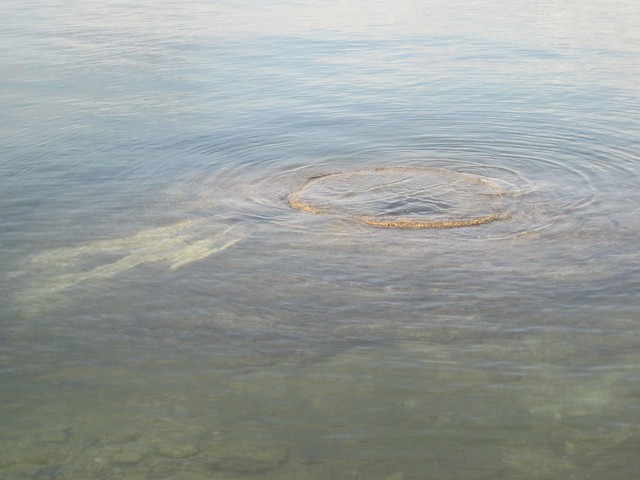
Fishing Cone: the underwater geyser near Yellowstone Lake
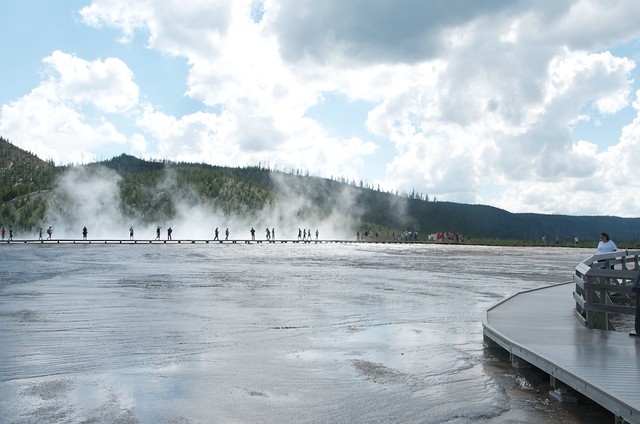
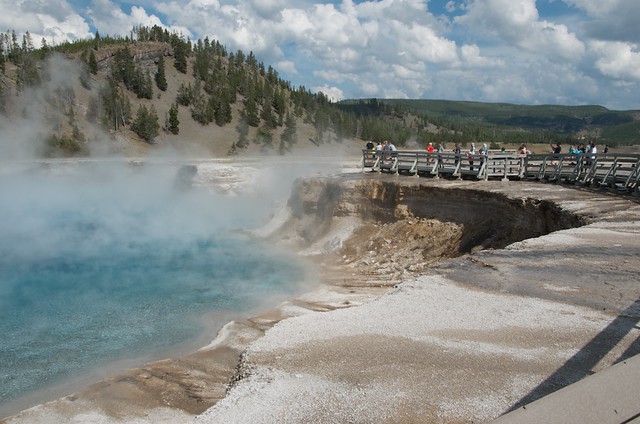
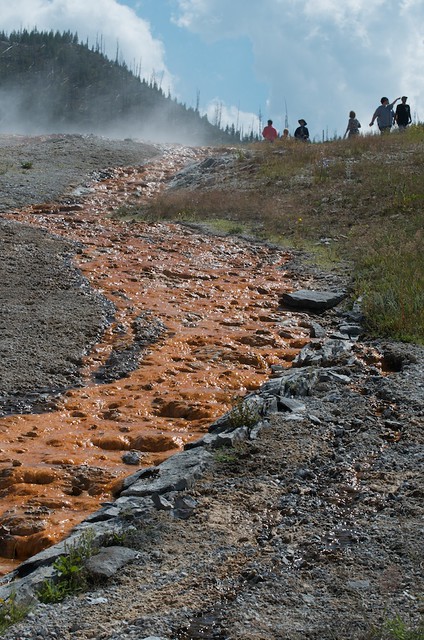
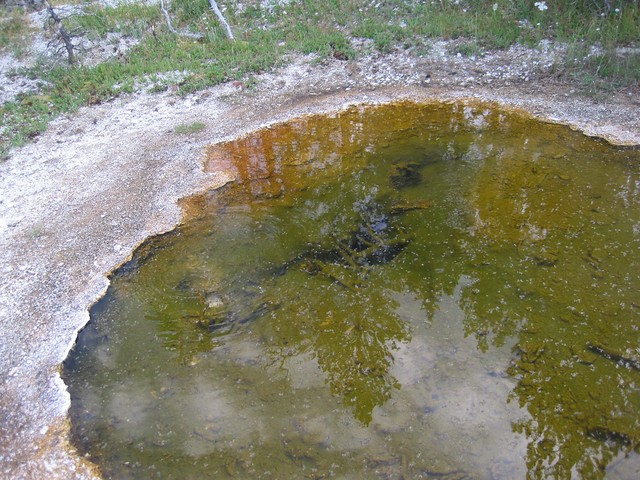

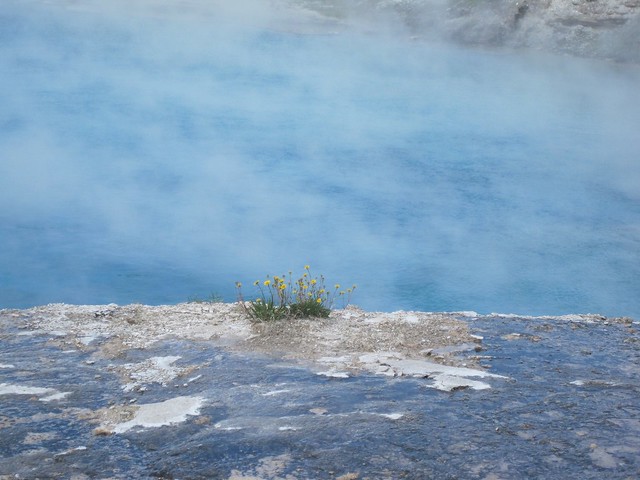
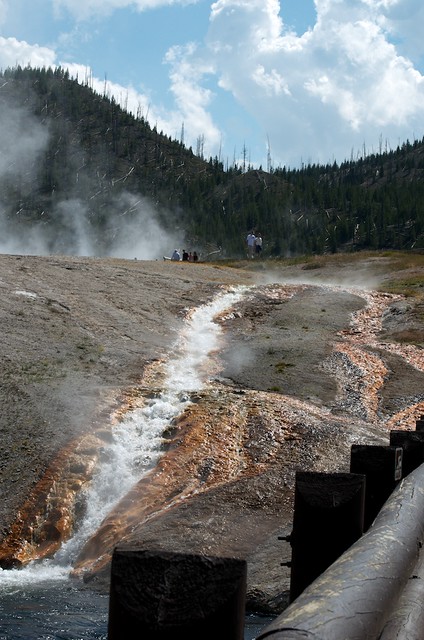
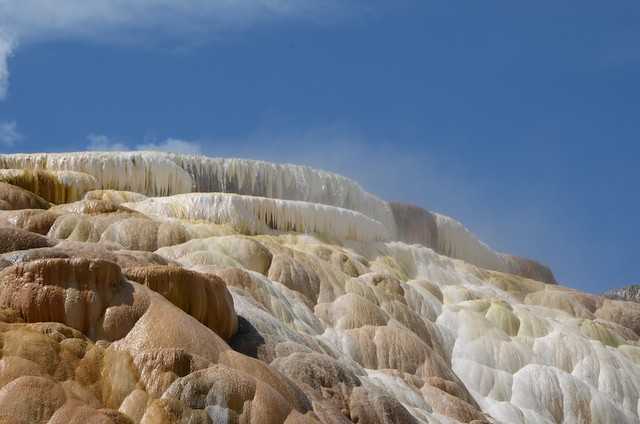
Mammouth Hot Springs Limestone Formations
Tomorrow: the geysers.
The punctual eruptions of Old Faithful are tamer, with crowded bleacher seats in front of the National Park Information Center as everyone waits for the steam and hot water to begin to spout. The dozens of smaller but equally extraordinary geysers in the nearby geyser field require around a 90 minute walk along carefully designed boardwalks. I know the timing, because Old Faithful was just erupting when we began our walk, and we saw it go off again as we were returning.
Hot springs, boiling pools, colorful heat-tolerant algae, accretions of limestone from hard water gushing out of the ground, and many other thermal features are abundant throughout the park. At the end of Yellowstone Lake, there's even a geyser just under the surface of the water, and many just beside the shore. Scrubby wildflowers and grasses grow right in the running hot water, and elk and other animals graze near steaming pools. It's all fascinating.
If you want a geology lesson, I'm afraid you won't get it here, though I learned a great deal in 3 days of exploring various hot spring and geyser basins and reading the useful labels and explanations supplied by the Park Service.
The following hot spring photos I've selected just because I like the way they look.

Fishing Cone: the underwater geyser near Yellowstone Lake








Mammouth Hot Springs Limestone Formations
Tomorrow: the geysers.
Subscribe to:
Posts (Atom)





